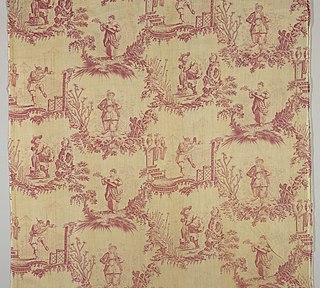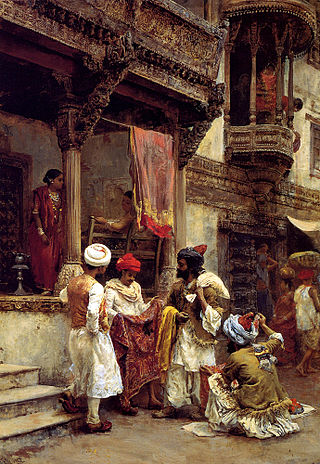Related Research Articles

Calico is a heavy plain-woven textile made from unbleached, and often not fully processed, cotton. It may also contain unseparated husk parts. The fabric is far coarser than muslin, but less coarse and thick than canvas or denim. However, it is still very cheap owing to its unfinished and undyed appearance.

Muslin is a cotton fabric of plain weave. It is made in a wide range of weights from delicate sheers to coarse sheeting. It is commonly believed that it gets its name from the city of Mosul, Iraq.

Flannel is a soft woven fabric, of varying fineness. Flannel was originally made from carded wool or worsted yarn, but is now often made from either wool, cotton, or synthetic fiber. Flannel is commonly used to make tartan clothing, blankets, bed sheets, sleepwear, and several other uses.

Crêpe, also spelled crepe or crape, is a silk, wool, or synthetic fiber fabric with a distinctively crisp and crimped appearance. The term "crape" typically refers to a form of the fabric associated specifically with mourning. Crêpe was also historically called "crespe" or "crisp".

Khadi, derived from khaddar, is a hand-spun and woven natural fibre cloth promoted by Mahatma Gandhi as swadeshi (self-sufficiency) for the freedom struggle of the Indian subcontinent, and the term is used throughout India, Pakistan and Bangladesh. The first piece of the hand-woven cloth was manufactured in the Sabarmati Ashram during 1917–18. The coarseness of the cloth led Gandhi to call it khadi. The cloth is made from cotton, but it may also include silk or wool, which are all spun into yarn on a charkha. It is a versatile fabric that remains cool in summer and warm in winter. To improve its appearance, khadi is sometimes starched to give it a stiffer feel. It is widely accepted in various fashion circles.

Percale is a closely woven plain-weave fabric often used for bed covers. Percale has a thread count of about 180 or higher and is noticeably tighter than twill or sateen. It has medium weight, is firm and smooth with no gloss, and washes very well. It is made from both carded and combed yarns, and may be woven of various fibers, such as cotton, polyester, or various blends.
Longcloth refers to a plain cotton cloth originally made in comparatively long pieces.

Broadcloth is a dense, plain woven cloth, historically made of wool. The defining characteristic of broadcloth is not its finished width but the fact that it was woven much wider and then heavily milled in order to shrink it to the required width. The effect of the milling process is to draw the yarns much closer together than could be achieved in the loom and allow the individual fibres of the wool to bind together in a felting process, which results in a dense, blind face cloth with a stiff drape which is highly weather-resistant, hard wearing and capable of taking a cut edge without the need for being hemmed.
In the context of materials, stuff can refer to any manufactured material. This is illustrated from a quote by Sir Francis Bacon in his 1658 publication New Atlantis: "Wee have also diverse Mechanicall Arts, which you have not; And Stuffes made by them; As Papers, Linnen, Silks, Tissues; dainty Works of Feathers of wonderfull Lustre; excellent Dies, and many others." In Coventry, those completing seven-year apprenticeships with stuff merchants were entitled to become freemen of the city.

Silk In India, about 97% of the raw mulberry silk is produced in the Indian states of Karnataka, Andhra Pradesh, Tamil Nadu and West Bengal. Mysore and North Bangalore, the upcoming site of a US$20 million "Silk City", contribute to a majority of silk production. Another emerging silk producer is Tamil Nadu in the place in where mulberry cultivation is concentrated in Salem, Erode and Dharmapuri districts. Hyderabad, Andhra Pradesh and Gobichettipalayam, Tamil Nadu were the first locations to have automated silk reeling units.
The manufacture of textiles is one of the oldest of human technologies. To make textiles, the first requirement is a source of fiber from which a yarn can be made, primarily by spinning. The yarn is processed by knitting or weaving, which turns it into cloth. The machine used for weaving is the loom. For decoration, the process of colouring yarn or the finished material is dyeing. For more information of the various steps, see textile manufacturing.
The Surat Zari / Jari Craft is a textile product of Surat district in Gujarat, India, which is made from yarns of silk and cotton mixed with gold, silver or copper. The zari threads are used to make intricate designs by weaving into generally silk fabrics. Its use is extensive in textile industries and handicrafts. The Surat Zari is either woven on cloth or hand embroidered to form fabric borders or used as part on the body of the cloth. The zaris are used in fabrics made in Varanasi and a few other places in Uttar Pradesh, Tamil Nadu, Karnataka and Andhra Pradesh. Banarasi saris made in Varanasi and Kanjivaram Saris of South India use Surat Zari extensively.
Khasa was a high-quality variety of calico cloth that was manufactured and used for clothing in the Mughal Empire.
Tansukh cloth was a fine cotton cloth primarily used for feminine dresses in medieval India, Tansukh is one of the seven explicitly mentioned cloths named in the exhaustive list of cotton cloths in Ain-i-Akbari. The bodices made of Tansukh and Bafta are referred by the poet Bhikhari Das. Tansukh was a woven material with another class of muslin with a very soft and delicate texture.

Piece goods were the textile materials sold in cut pieces as per the buyer's specification. The piece goods were either cut from a fabric roll or produced with a certain length, also called yard goods. Various textiles such as cotton, wool, silk, etc., were traded in terms of piece goods. The prices were determined as per the fabric quality.

Mashru is a woven cloth that is a blend of silk and cotton. It was historically a hand-woven satin silk fabric variety found in the Indian subcontinent, and its proper use is described in the 16th-century Ain-i-Akbari.
Adhotar was a coarse variety handloom cloth with a loosely woven structure. Adhotar was a cloth of locals in the early 19th century. It was one among various other Indian handloom fabrics such as khaddar, garha, dres, and Khasa.

Negro cloth or Lowell cloth was a coarse and strong cloth used for slaves' clothing in the West Indies and the Southern Colonies. The cloth was imported from Europe in the 18th and 19th centuries.
Sannas was a cotton cloth from the 17th century. This fabric was plain weave cotton, which was produced in the Indian state of Orissa. After 1640, huge quantities of Sannas were exported to Europe. Sannas, Cassas, and Bafta were among the Indian textiles exported for shirting and sheeting uses. Sanna was mostly white or blue in colour.
Delaine was a kind of mixed cloth with cotton warp and wool in the weft. Delaines have many variations such as made of undyed yarns, and also printed or piece dyed. Delaine was a type of cloth used to manufacture women's dresses that was traded in the nineteenth century under many names to suit importers and traders. Moreover, it appeared that the plaintiffs' goods differed from delaines in various other respects.
References
- ↑ Peck, Amelia (2013). Interwoven Globe: The Worldwide Textile Trade, 1500-1800. Metropolitan Museum of Art. p. 305. ISBN 978-1-58839-496-5.
- ↑ Kausar, Zinat (1992). Muslim Women in Medieval India. Janaki Prakashan. p. 63. ISBN 9788185078748.
- ↑ Montgomery, Florence M. (1984). Textiles in America 1650-1870 : a dictionary based on original documents, prints and paintings, commercial records, American merchants' papers, shopkeepers' advertisements, and pattern books with original swatches of cloth. Internet Archive. New York; London : Norton. p. 152. ISBN 978-0-393-01703-8.
- ↑ Pawar, Appasaheb Ganapatrao; University, Shivaji (1971). Maratha History Seminar, May 28–31, 1970: Papers. Shivaji University.
- ↑ Chaturvedi, Archna (2003). Encyclopaedia of Muslim Women: Muslim women and society. p. 158. ISBN 9788171697854.
- ↑ Yule, Henry (1996). Hobson Jobson : the Anglo-Indian dictionary. Internet Archive. Ware : Wordsworth. p. 47. ISBN 978-1-85326-363-7.
- ↑ Gokhale, Balkrishna Govind (1978). Surat in the seventeenth century.
- ↑ "vol1_chapter05". www.columbia.edu. Retrieved 2020-10-01.
- ↑ Lee, Peter (2014). Sarong Kebaya: Peranakan Fashion in an Interconnected World, 1500–1950. University of Minnesota: Asian Civilisations Museum. p. 75. ISBN 9789810901462.
- ↑ Giorgio Riello, Tirthankar Roy (2009). How India Clothed the World. BRILL. pp. 318, 332. ISBN 9789004176539.
- ↑ "Bafta | Definition of Bafta by Oxford Dictionary on Lexico.com also meaning of Bafta". Lexico Dictionaries | English. Archived from the original on October 28, 2020. Retrieved 2020-10-01.
- ↑ Tavernier, Jean-Baptiste; Phillips, John (1905). Travels in India. Duke University Libraries. Calcutta, "Bangabasi" Office. p. 52.
- ↑ Milburn, William (1813). Oriental Commerce: Containing a Geographical Description of the Principal Places in the East Indies, China, and Japan, with Their Produce, Manufactures, and Trade, Including the Coasting Or Country Trade from Port to Port: also the Rise and Progress of the Trade of the Various European Nations with the Eastern World, Particularly that of the English East India Company from the Discovery of the Passage Round the Cape of Good Hope to the Present Period: with an Account of the Company's Establishments, Revenues, Debts, Assets, and C. at Home and Abroad [...]. author and published. p. 46.
